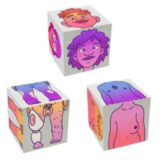The body parts on the dice have different skin tones, since human beings come in many colours. Thus, the idea is not to match the heads with the upper and lower bodies by colour, but to remember that skin tone and racialised facial features are often used to discriminate against people. Children intuitively notice physical differences, but the meanings attached to those differences usually come from adults – and, for historical reasons, mainly from White adults.
For adults who have not personally experienced racial discrimination, it may seem unimportant or too difficult to discuss this topic with their children. However, silence allows interpretations of colonial history to continue. You don’t need to have all the answers – what matters is the courage to start the conversation. The Body Dice are designed to support these conversations by building empathy. To start talking about racism, you might ask your child about their own skin tone, and those of family members, friends, or characters in books and on television.
Who do you often see, and who is missing? Has any of them ever been the target of a racist comment? How would your child feel in that person’s place? And what could a friend do to show support? Do people with different skin, hair or eyes than most of ours belong here, too?
Beyond varieties in skin colours and hair, some people have light patches on their skin, which are known as vitiligo. Like moles, freckles, or birthmarks, vitiligo is just another form of uneven skin colouring. Many people wear it with pride, but sometimes the stares or questions of others can make people with vitiligo feel uncomfortable. The same can happen to people with burns or scars.
Because it can be pretty or meaningful, there are even people who modify their skin on purpose. For example, one of the torsos on the dice has a tattoo. Do you know anyone with a tattoo? What might it mean to them?
Now take a look at the hair on the chests, genitals and legs. Body hair naturally varies in amount, but it can also be removed or added artificially. Think of this with your child: why might someone want to add or remove their body hair?
